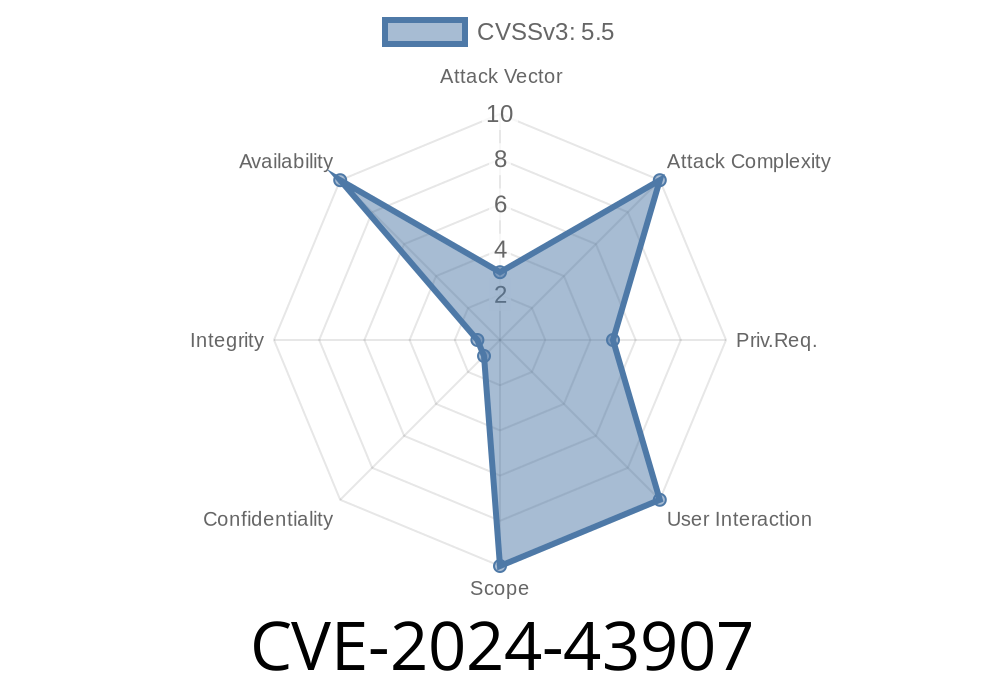In June 2024, the Linux community patched an important bug in the kernel’s AMDGPU driver. This flaw, found under the code section drm/amdgpu/pm: Fix the null pointer dereference in apply_state_adjust_rules, had the potential to crash systems or even become a target for local exploits if left unaddressed. Let's walk through CVE-2024-43907, what caused it, how it was fixed, and the lessons we can all learn as Linux users and developers.
What Is CVE-2024-43907?
CVE-2024-43907 is the unique identifier assigned to a vulnerability in the Linux AMDGPU driver. Specifically, it involved a null pointer dereference in the apply_state_adjust_rules function. In everyday terms, this means the driver sometimes tried to access memory using a pointer, but the pointer was NULL (i.e., pointing to nothing), causing a kernel crash.
A null pointer dereference is a classic mistake in programming, but in the kernel, it’s critical: not only can it cause a crash (a “kernel panic”), but with careful setup, it could also potentially be abused for more serious attacks such as privilege escalation.
Where Was the Bug?
The bug lived in the power management (“pm”) component of the AMDGPU driver. Here, the function apply_state_adjust_rules() is used to tweak the GPU’s power state under different circumstances.
The core issue? The code didn’t always check whether a pointer was valid before using it. If the function received a NULL pointer, it would try to use it anyway and crash the kernel.
Here’s an example (simplified for clarity) of what might go wrong
// Before the fix:
void apply_state_adjust_rules(struct amdgpu_device *adev) {
// ... some code ...
adev->pm.some_member = something; // <--- 'adev' could be NULL!
// ... more code ...
}
If adev was NULL, trying to access adev->pm would trigger a crash immediately.
How Did They Fix It?
The kernel developers added a simple but essential check: making sure the pointer isn’t NULL before using it. This way, if a bad or unexpected value arrives, the code gracefully returns early instead of risking catastrophe.
Fixed Code (Simplified)
void apply_state_adjust_rules(struct amdgpu_device *adev) {
if (!adev) // this line is the fix!
return;
// ... safe to use 'adev' now ...
adev->pm.some_member = something;
}
This is considered best practice: Always check pointers before dereferencing them!
In the context of this bug
- Local users (those with access to the system) could potentially trigger the kernel crash by sending crafted commands to the GPU device.
- Remote exploitation is highly unlikely unless someone can trick the system into reaching this code through networking, which in this case isn’t expected.
- Privilege Escalation: While this bug mainly causes denial of service (crash), clever attackers may sometimes chain null pointer dereferences with other bugs to achieve more serious results.
A Simple Exploit PoC
While a generic proof-of-concept (PoC) isn’t published for CVE-2024-43907 yet, a would-be attacker could do something like this:
#include <stdio.h>
#include <fcntl.h>
#include <sys/ioctl.h>
int main() {
int fd = open("/dev/dri/card", O_RDWR);
// Send crafted IOCTL or command structure that triggers the bug
// e.g., memset to zero or null-out expected pointers.
// (Exact details depend on kernel version and will vary)
close(fd);
}
*Disclaimer: This is illustrative! Do not run code that you don't fully understand, especially on production systems.*
References
*This is the exact patch that fixed the issue.*
- CVE Entry (CVE-2024-43907) on NVD
What Should I Do?
1. Update Your Kernel: Make sure your Linux distribution includes the latest kernel with this patch (June 2024 or later).
Conclusion
CVE-2024-43907 is a reminder that even small coding mistakes—like missing a pointer check—can have big consequences in the Linux kernel. Thanks to the vigilance of open source developers, the bug was found and patched quickly.
If you work with kernel code, always check your pointers. If you just use Linux, keep things patched and updated. Stay safe!
Links
- Linux Kernel Source
- AMDGPU Driver Documentation
- CVE-2024-43907 at NVD
*Thanks for reading. Share this with fellow sysadmins and Linux enthusiasts so we can all build more secure and robust systems!*
Timeline
Published on: 08/26/2024 11:15:05 UTC
Last modified on: 08/27/2024 13:41:40 UTC
